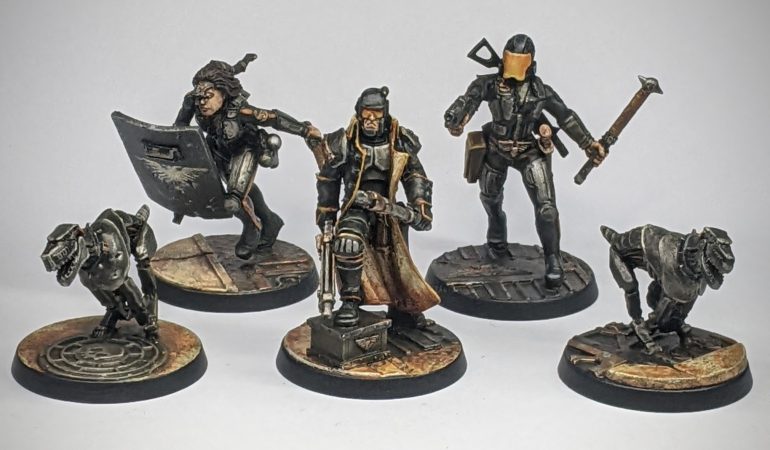
Hello, and welcome back for another entry in The Battle for the Emperor’s Soul – the series that charts my descent into madness expanding collection of 54mm miniatures for the venerable Games Workshop specialist game Inquisitor. In Part One, I talked about why I started getting into Inquisitor 54mm in the first place, what I like about it and showcased the miniatures for my Witch Hunter Tyrus warband. This time, I’m going to focus on my small Enforcer warband, explain where it came from and why it excites me.
The reason for this warband all comes back to the model Barbaretta. Before I had the model in my hand – when my only experience with this model was photographs of painted miniatures on the internet – I got it in my head that the head looked a little, uh.. doofy. Concerned about this, before I actually received Barbaretta, I went hunting for an alternative head – and managed to get myself one of the Lucretia Bravus upgrade kits. These kits feature not one, but two additional helmeted Enforcer heads along with a replacement arm aiming a stub pistol. When I eventually received my Barbaretta, in the end, I opted not to use any of these bits on the model, keeping it completely stock. In truth, while Barbaretta certainly has a bit of a ‘hand sculpted’ vibe to her, the bare head in hand looks nowhere near as akward as I expected from the photo on the box art.
Time passed and I had finished my Tyrus warband, but I still felt those leftover bits burning a hole in my pocket. Gradually, the wheels began to turn and a thought popped into my head – what if this could be my 2nd Inquisitor project?
The original motivation behind painting these 54mm Inquisitor miniatures has always been to learn the ruleset using stock characters and warbands, but after leafing through the hobby section of the Inquisitor rulebook, it’s hard to deny the appeal of converting up a thematic and unique warband in 54mm. There’s a lot of interesting conversions present in the book, varying wildly from simple head and weapon swaps to ambitious creations made from extensive kitbashes and even hand sculpting. Moreover, the Inquisitor game explores a wide range of interesting minor factions beyond Inquisitorial retinues – ranging from small squads of Imperial Guardsmen to Kroot Stalkers and Eldar Rangers. The idea of having a small warband of these ‘less significant’ kinds of models for lower stakes games or even as NPC’s appealed to me – as did having a second warband to hand on the off-chance I find myself able to run a demo game locally.
At this point, I was pretty much sold on the idea and decided to expand from Barbaretta with a further two (and a half) miniatures for reasons I’m just about to get into. The first was that if I wanted this warband to be useful for demoing the game to people, I’d want to roughly match the model count of my Witch Hunter Tyrus warband – which would be three, in this instance, with Barbaretta defecting back to the side of local law enforcement. Inquisitor doesn’t really have a ‘points’ system for measuring power1, but instead relies on good judgement and scenario creation to keep things ‘interesting’ if not necessarily ‘fair’ from the outset. The scenario I’m playing with in my head, then, would be the origin story for Barbaretta’s recruitment into Tyrus’ warband and encourage players to reach the canon conclusion of Barbaretta siding with Tyrus. In this situation, Tyrus would have the advantage due to the Inquisitors statline, but both players at least have equal amounts of miniatures to play with rather than one team getting to interact more than the other.
The other reason for building the warband up to a total of three miniatures (plus the two Cyber Mastiffs) was kind of just the limits of my own creativity. As far as Law Enforcement models in the Inquisitor range go, the options are pretty much limited to Arbites Judge (a rare and now expensive Inquisitor model) and Barbaretta and her Lucretia Bravus upgrade kit. While the Judge does come with three head options, the stoic pose and the trenchcoat really gives this model the vibe of a warband leader rather than a henchman. This combined with the rarity and expense of the miniatures themselves pushed me towards using just the one in the warband. Barbaretta was, mercifully, far easier and cheaper to get a hold of a second time (even with the less commonplace Lucretia Bravus upgrade parts) – but her very specific pose makes her an awkward model to re-use too many times. Additionally, while the balance of male/female models feels somewhat reasonable and believable at one male Judge and two female Enforcers, having a single male leading a squad of three female Enforcers starts to feel a bit much like a male power fantasy for my tastes. Maybe I’ll figure out a way to convert a male Enforcer in the future, but for now I’m sticking with one Judge and two Enforcers.
As I was working with two relatively similar miniatures here, I decided to build and paint the pair of them at the same time. For the build, the Judge was pretty simple, consisting of five main components – the main body, a head option, two arms and an ammo crate or something functioning as a Tactical Rock. Although the base miniature looks pretty good generally, I thought the ‘dangling’ arms looked a little stiff and awkward when I had the model in hand, so decided to make a few adjustments of my own. These were fairly simple changes – snip the arms around the elbow joint, reposition and resculpt the elbow – although it took a good bit of experimentation to figure out what looks right. In the end, I gave the gun arm a bit of bend at the elbow – still dangling, but a little less limp – and had him raising his baton a little closer to his chest. These were fairly simple changes add a little more drama to the pose. Better yet, the green stuff work needed here was pretty basic, especially as the sleeves on the Arbiters trenchcoat were pretty forgiving on my pretty much non-existent sculpting skills.
Lucretia Bravus, my 2nd Enforcer, was a little more complicated. While generic standing or aiming poses tend to be fairly forgiving when duplicated, I find especially dynamic or unique poses such as Barbaretta’s sprint look really obvious when they’re duplicated. Unfortunately, this sprinting pose also meant that I’d need to do significant work to change it up, so I grit my teeth and started hacking away at the pewter to try and undo the hunch. This involved snipping in three major locations – a pretty huge cut across the lower torso, enough so that I could bend the pewter back until she stood upright – and then two snips to the left leg – one behind the inner thigh and another behind the knee. This allowed me to unbend the lifted knee and straighten it out into a more of an advancing pose rather than a full sprint. Doing this, of course, left me with some pretty enormous gaps to fill. The legs were surprisingly simple – there’s not a lot of detail on the body glove, so it was simply a case of filling the gap and sanding it down until the green stuff was seamless with the pewter. The lower torso, however, was not so simple. Not only did I have to resculpt some of the detail that I destroyed – the bottom of the body suit, the belts/harnesses, etc – but also I had to extend the flak jacket due to the increased height from bending the torso back. None of this was remotely in my wheelhouse, but it was a pretty fun challenge regardless. The end result was.. mixed. I’m pretty pleased with my the flak jacket extensions worked out, but the zip resculpt ended up way chunkier than the existing detail – and it’s pretty noticeable after painting.
To help distract from and conceal some of my janky hand-sculpted detail, I added an aquilla belt buckle (a leftover bit from the Tyrus kit), as well as a holster for the stub pistol (another leftover bit from Devotee Malicant with the flames filed off) and a sheathed knife (leftover from Sergeant Stone). Carrying a knife instead of Barbaretta’s bolos helps give Bravus a bit more of a ‘lethal’ feel, which vibes well with her brandished stub-pistol, I thought. Speaking of the pistol – I kind of hated that Bravus aims the pistol on its side like some cheesy 90’s cartoon thug, so I ended up chopping up her arm to repose until the stub pistol was being aimed a little more professionally like I imagine an Enforcer would. To finish up, I slung the shotgun over her back and glued the visored helmet to her shoulders and the mini was finished. I also had another Cyber Mastiff with this 2nd Barbaretta, so I glued that model together as well. This time, I snipped the head off at the collar and glued it back on at a slight angle, to give the new Mastiff a very slightly different pose from the original to help tell them apart a little on the tabletop.
The construction and conversion of these miniatures was by some measure the most complicated part of the job. Bravus was painted pretty much the same as Barbaretta, with fairly standard metallics over the flak armour and successively brighter and smaller layers of grey applied over the bodysuit followed by a blending layer of Nuln Oil. The most complicated part of the paint job here was painting the visor. A base coat of Hot Orange was followed by layers of Orange Fire with increasing amounts of Bald Moon Yellow mixed in towards the centre of the visor, then finally edge highlighting with a little Elfic Flesh mixed in there. Pretty easy – and way less stressful than trying to freehand an Imperial Aquilla on Barbaretta’s riot shield.
The Arbites Judge wasn’t any more difficult, to be honest. Everything as above was applied to this model with the added caveat of painting the lining of his coat in Elfic Flesh, washing with a watered down Seraphim Sepia then layering the raised areas in Elfic Flesh again. The final touch was a little Fuegan Orange painted towards the base of the coat for staining (and that 40K aesthetic). When both the miniatures were finished, I slapped a little Streaking Grime over the pair of them and wiped the majority of it off with mineral spirits – giving the models with a gritty, desaturated and grimdark finish without tinting or shifting the overall look of the minis too much.
And that’s.. it, really, other than fairly self explanatory bits like orange trim and leather holsters. Despite the size of these miniatures, they really weren’t all that difficult or time consuming to get painted up to a pretty decent tabletop standard. Sure, I could’ve spent longer glazing the folds in the Judge’s trenchcoat in order to get smoother, creamier blends – but there’s value in quick wins, sometimes. After spending the last month painting my Thunderhawk, it was pretty cathartic to bash something out in a weekend.
With that, my small warband of Enforcers is complete. I’m really happy with how the miniatures turned out and how everything looks together. It’s been great to explore both converting Inquisitor miniatures in 54mm pewter, as well as engaging with this niche corner of the Warhammer 40,000 universe. Adeptus Arbites are a faction I’ve been fascinated by since they were released in 28mm for Necromunda two decades ago, and it’s been a lot of fun painting one in 54mm. Better yet, I’ve now got a few options now for playing 54mm Inquisitor, whether it’s providing two factions worth of miniatures for a demo game or allowing more variation in power level for what I can bring along to a game. Both very handy options to have for a specialist game from two decades ago.
Speaking of demo games, I’ve got one last thing to show you before I draw a line under Inquisitor for now. With potentially two warbands now available to game with and plenty of D10s to hand (thanks in no small part to Dungeons & Dragons), I felt like I should have some Inquisitor compatible terrain on the premises, just in case.
Generally speaking, Inquisitor should be played on a 4×4 space with a relatively dense set of terrain – something like a 2×2 square of a Mordheim or Necromunda blown up to twice the size. That would be a lot of terrain to collect from scratch, however – mercifully – quite a lot of 28mm terrain works equally as well for 54mm games. Just about anything that doesn’t have human scaled features works well – big boxes and crates, rock formations and other landscape features work well. Ruins with doors, anything with mounted weapons, handles or foot holds not so much. Going through my terrain box, I actually found a good amount of useful stuff. A lot of it seems to be the prepainted resin terrain that I’ve collected from various gaming mat companies. I’ve got a couple sets of Industrial Pipes from UrbanMatz which are probably twice the size of the Thermic Plasma Conduits I have from Games Workshop. These pair well with most of the Gamemat.eu Industrial Terrain set, which contains crates and armoured containers more than twice the size of Games Workshop’s Munitorum Armoured Containers. Together, that’s a pretty good balance of completely LOS blocking terrain, obscuring features and chest high cover – it’s a decent set that will do me in a pinch, but it lacks a centrepiece. Enter my new 54mm Imperial STC Colonial Habitat.
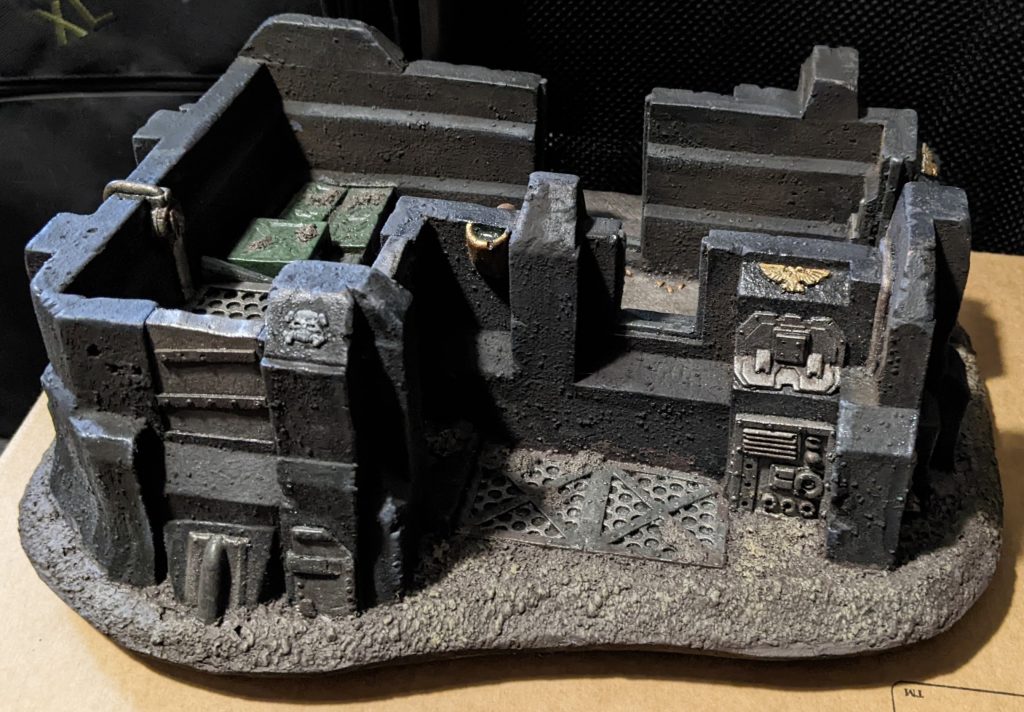
This is a pretty old school terrain piece, cast in a sturdy expanding foam and sold originally by ForgeWorld, or so I’m told – I can’t find any real reference to link to, I’m afraid. I found this piece of eBay for a pretty reasonable price while searching for some specific 54mm terrain and I’m really happy with it. It’s lightweight, sturdy, reasonably detailled and looks every millimetre an Imperial structure. Better yet, it looks at completely at home with the rest of the Industrial terrain and will make a nice centrepiece for 54mm miniatures to fight over or take cover in.
I can’t take credit for the paint job on this one – it arrived already painted in this simple but pleasing black scheme with some weathering powders providing a little depth to the surfaces and the details already picked out neatly in desaturated tones. I didn’t want to mess with it too much, though I did pick out the edges in grey with a drybrush and sponged on some paint chips here and there to give the black a little more definition. It seems to have done the trick, and I’m happy with how it looks overall.
Alright, well, that about does it for this entry in The Battle for the Emperor’s Soul. It’s been a brief, but enjoyable palette cleanser following the Thunderhawk, but I’m ready to get back to serious business army painting again. There’s a lot of hype around Horus Heresy right now, and as much as I try not to get sucked into the hype machine, it’s definitely got me thinking about a few of the kits that’ve been languishing on my backlog for a while now. Could it finally be time to paint those MKV Destroyers?
Until then, thanks for reading and happy wargaming!
1 Well, it does.. Kind of. There’s a system called the Ready Reckoner in the Appendix, but both players and even the game designers themselves all kind of agree it’s less helpful than just going with your gut, given the sort of game that Inquisitor is.
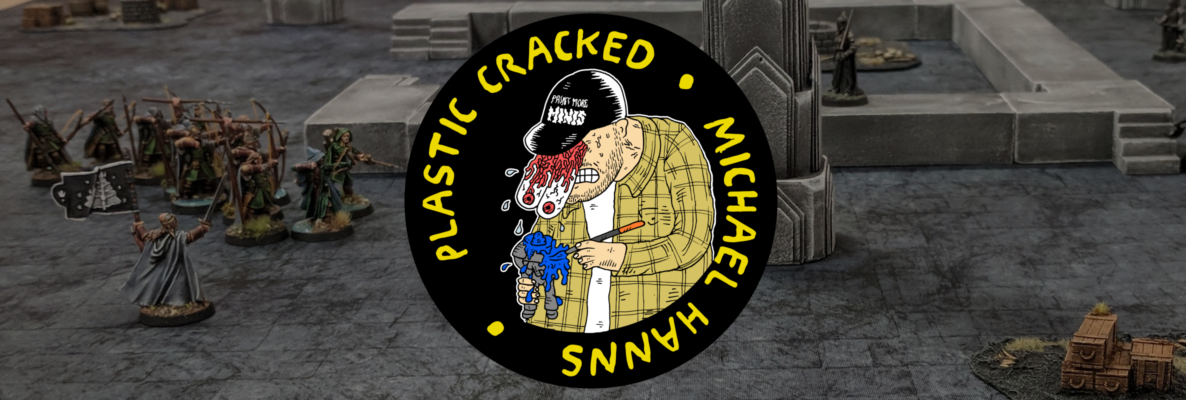
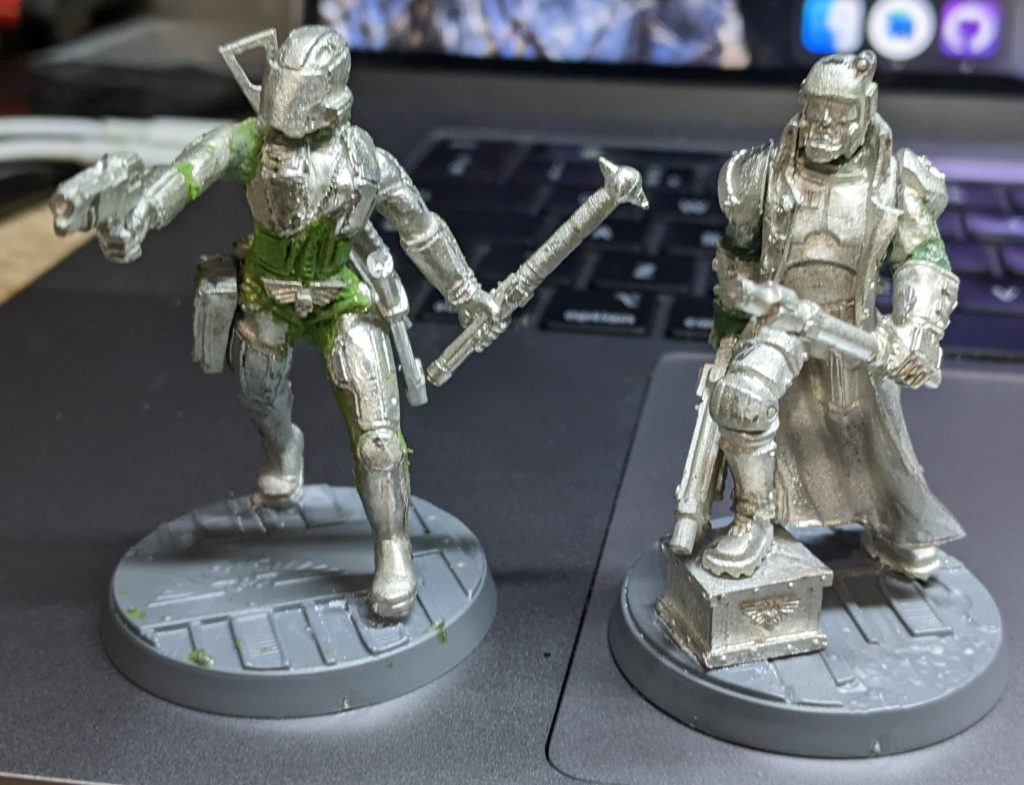
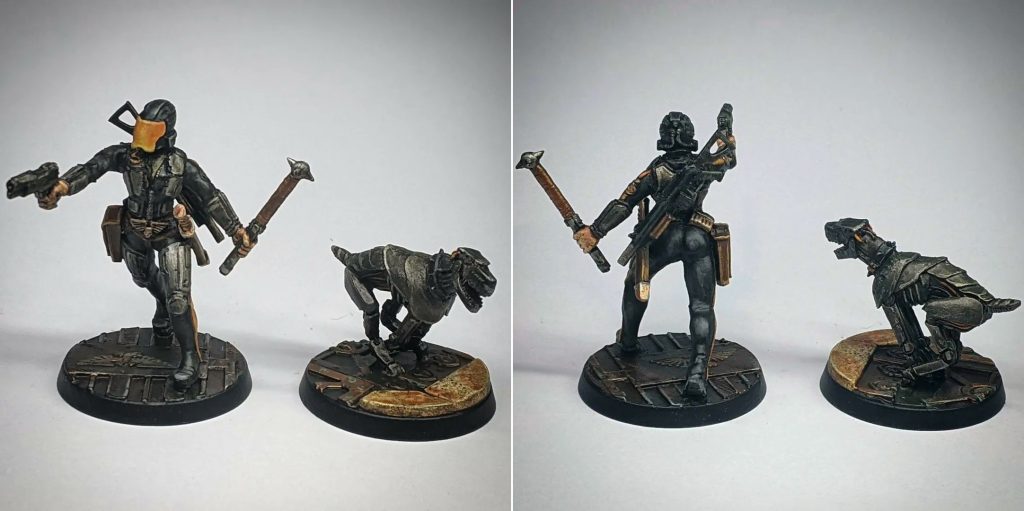
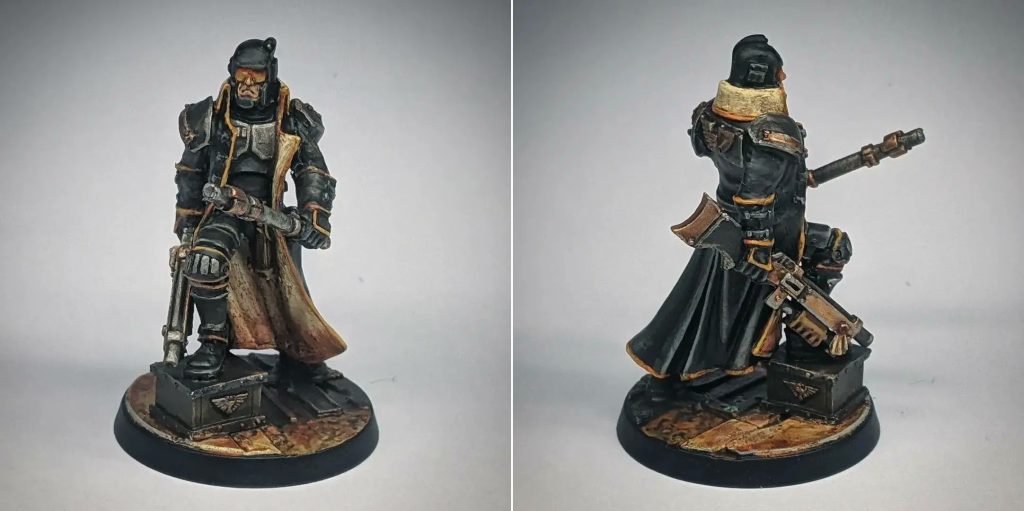
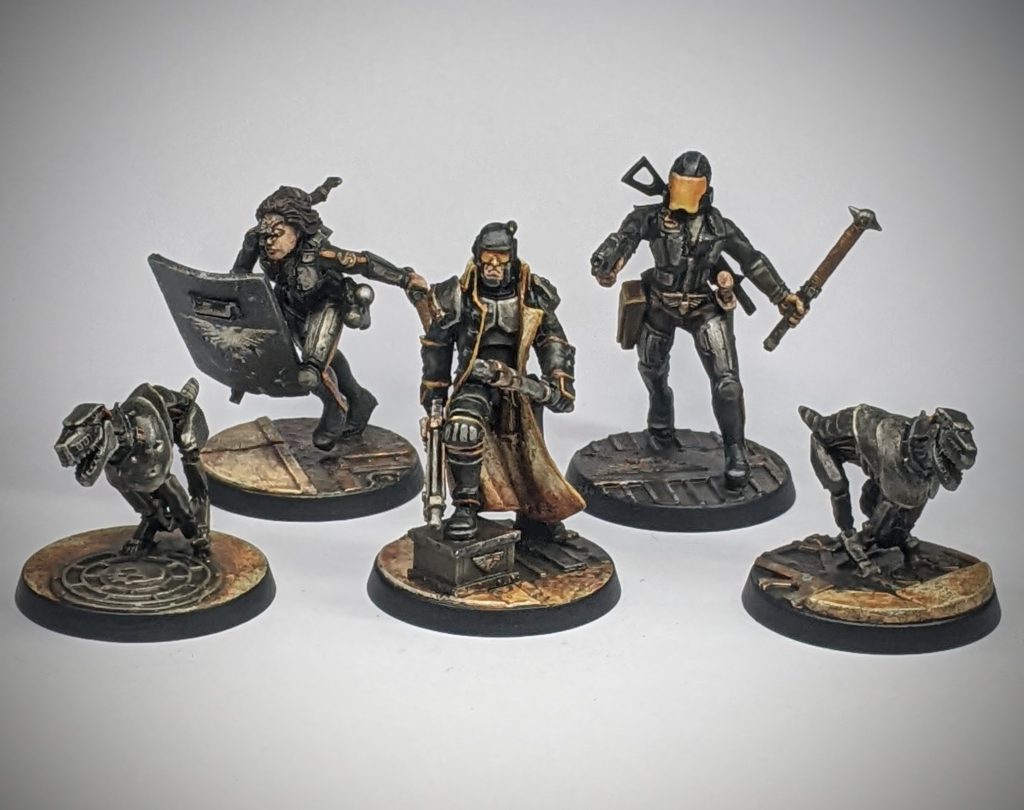
I just read something you did a little over a year ago. The battle for the Emperors soul part 2. I love what you did this arbites squad, they look fantastic.
I started collecting 54mm minis a few years back and now have a couple hundred grim dark miniatures representing two bands of Ordo Malleus (one male, one female) each with around a dozen miniatures, a Rogue Trader band, an Ordo Hereticus band which includes several Space Marines (one female – heresy what heresy – look away nothing to see here), an Ordo Zenos band with squats, eldar, ogryn, and a blue skinned hottie, and then other humans like a ratskin gang, a chaos warband, a catfolk warband, a warband made of fifteen Tharks (three mounted on Thoats from The Warlord of Mars books), and an orc warband four of whom are mounted on wardrakes, and other bits and pieces.
I might have got a bit carried away but I had planned on using this scale for roleplaying a homebrewed inquisimunda game, which due to moving to the middle of nowhere, never eventuated.
Its good to see folk keeping the scale alive.